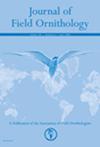国王Rail (Rallus elegans)对音频回放的反应:对种群估计、监测方法和诱捕方法的影响
IF 0.9
4区 生物学
Q3 ORNITHOLOGY
引用次数: 1
摘要
。广播同种音频可以提高隐蔽沼泽鸟类的探测概率(可探测性),用于种群监测目的,并作为更有效诱捕个体的诱饵。我们的主要目标是将King Rail (Rallus elegans)的可探测性描述为距离的函数,从而确定在呼叫广播调查期间,与调查点相邻的完美可探测性的距离抽样假设是否被违反。我们还描述了在音频广播调查中影响King Rail可探测性的因素,以及如何以及何时检测到该物种本文章由计算机程序翻译,如有差异,请以英文原文为准。
King Rail ( Rallus elegans ) response to audio playback: implications for population estimation, monitoring methodology, and trapping approach
. Conspecific audio can be broadcast to improve detection probability (detectability) of secretive marsh bird species for population monitoring purposes and as a lure to more effectively trap individuals. Our primary objective was to describe King Rail ( Rallus elegans ) detectability as a function of distance and so determine if the distance sampling assumption of perfect detectability immediately adjacent to survey points was violated during call-broadcast surveys. We also described what factors affected King Rail detectability during audio broadcast surveys, and how and when this species was detected
求助全文
通过发布文献求助,成功后即可免费获取论文全文。
去求助
来源期刊

Journal of Field Ornithology
生物-鸟类学
CiteScore
1.40
自引率
0.00%
发文量
22
审稿时长
3 months
期刊介绍:
The Journal of Field Ornithology welcomes original articles that emphasize the descriptive or experimental study of birds in their natural habitats. Articles depicting general techniques, emphasizing conservation, describing life history, or assessing published studies or existing ideas are appropriate. The Journal is especially interested in field studies conducted in the Neotropics and those involving participation by nonprofessional ornithologists.
 求助内容:
求助内容: 应助结果提醒方式:
应助结果提醒方式:


